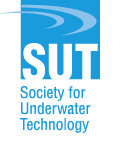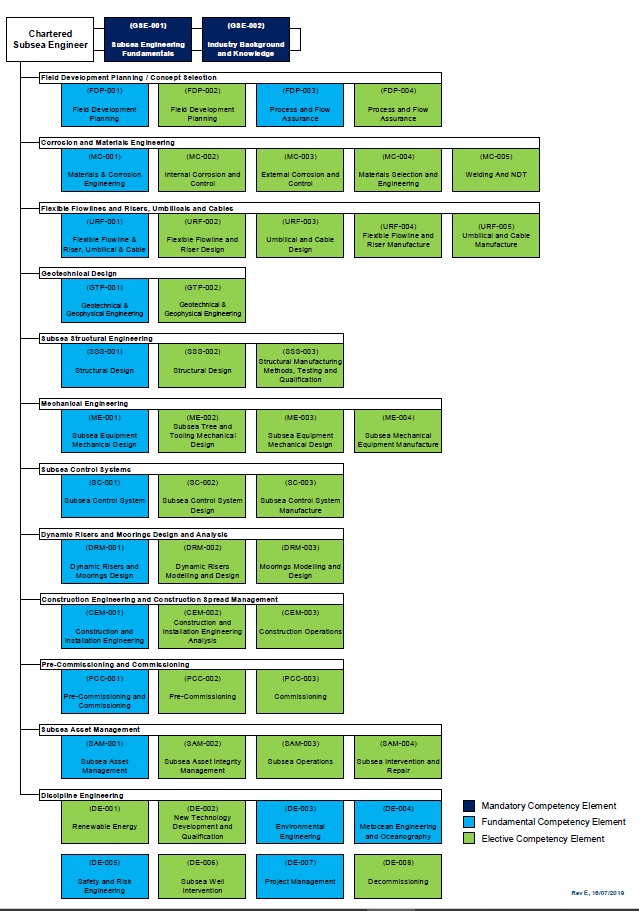Subsea Engineering
Subsea Engineering Competency Framework including:
-
- Overview
- Acknowledgements
- Career Planning Tool
- Links to Engineers Australia
- Chartered Recognition
- CPEng (Subsea)
- CEngT (Subsea)
- CEngA (Subsea)
1. Overview:
Subsea Engineering deals with the design, construction, installation, operation, maintenance and decommissioning of equipment in the ocean or on the seabed. Subsea engineers are engaged in managing activities throughout the asset lifecycle within various industries such as upstream oil and gas, marine/maritime and renewables.
Some of the activities that may be undertaken when practising as a Subsea Engineer include:
- Design of process, structural, corrosion, mechanical, controls or transmission elements
- Designing subsea gathering facilities for hydrocarbon recovery or renewables
- Manufacture and fabrication of subsea equipment and hardware
- Installation engineering for different types of subsea equipment
- Management or support of marine operations
- Intervention and repair operations by ROV or divers
- Asset integrity management of subsea equipment
- Support of subsea well intervention operations
- Decommissioning of facilities
These activities could take place in any of the following subsea engineering domains. A competent subsea engineer will practice in one or more areas, including:
- Field Development Planning / Concept Selection
- Corrosion and Materials Engineering
- Flexible Flowlines and Risers, Umbilicals and Cables
- Geotechnical Design
- Subsea Structural Engineering
- Subsea Mechanical Engineering
- Subsea Control Systems
- Dynamic Systems Design and Analysis
- Construction Engineering and Construction Spread Management
- Pre-Commissioning & Commissioning
- Subsea Asset Management
- Renewable Energy
- Environmental Engineering
- New Technology Development and Qualification
- Safety and Risk Engineering
- Subsea Well Intervention
- Project Management
- Decommissioning
The Subsea Engineering Competency Programme
- Initiative: by SUT (Perth Branch) in conjunction with industry
- Intent: Subsea Engineering to be recognised as an Area of Practice (AoP) by Engineers Australia (EA)
- SUT to provide the basis for technical assessment in the AoP of Subsea Engineering.
- SUT to support EA with the technical assessment of submissions for recognition in the AoP of Subsea Engineering
- Benefits: a career planning tool and personal recognition as a competent subsea engineer, which is recognised in Australia and Internationally.
Our objectives:
- Clearly identify the elements of competence, what they mean in practice and indicators of attainment required to be assessed as competent
- Identify the roles and responsibilities the subsea engineer will be competent to undertake
- Provide clear assessment criteria
- Have a consistent format to the competency profiles
- Have a consistent approach to describing competencies that reflects best industry practice
Available Now:
- Assessment and Accreditation for:
-
-
- Chartered Professional Engineer (Subsea)
- Chartered Engineering Technologist (Subsea)
- Chartered Engineering Associate (Subsea)
-
- Inclusion on the National Engineering Register (NER)
- Inclusion on the APEC Engineer register
- Inclusion on the International Professional Engineers Agreement register
2. Acknowledgements:
The SUT would like to acknowledge the following individuals and companies for all their efforts:
Sub-committee Members
Nick Bardsley, Keith Bentley, Mark Casey, Afton Galbraith, Terry Griffiths, Rex Hubbard, Chris Merrick, Matt Moore, Julie Morgan, Norman O’Rourke, Ewan Rowell, Chris Saunders & Ian Wilson (Team Lead)
Peer Reviewers
Guillaume Allegret, Peter Baker, Sotiri Battalis, Paul Breen, Peter Clarke, Moya Crawford, David Cree, Brendon Fitzgerald, Nino Fogliani, Stuart Folkard, Keith Fraser, Roland Fricke, Brian Guest, Paul Johnstone, Andy Lane, Sylvain Lyonnet, Harry MacKay, Jason McConochie, Kevin Mullen, Peter Rash, Bryson Riddler, Phil Robertson, Ewan Rowell, James Shorthouse, Harvey Smith, Stuart Wales, Brian Wardlaw, Saul Wende, Mark Williams, Karl Woods
Authors
Rob Ash, Dave Barker, Eduardo Barros, Steve Buchan, Chris Carra, Peter Clarke, Bobby Chopra, Phil Daglish, Scott Drapper, Fiona Chow, Sarah Elkhatib, Afton Galbraith, Murdo Gillies, John Grapiglia, Terry Griffiths, Brian Guest, Rex Hubbard, Linden Jones, Dave Jordan, David King, Matt Lancien, Andrew Mahaffy, Malcolm McLeod, Chris Merrick, Ian Milne, Julie Morgan, Tony Owen, Norman O’Rourke, Peter Page, Bryson Riddler, Bill Russell-Cargill, Allison Selman, Chris Selman, Margot St Quintin, Liz Tellier, Ian Wilson, Adriano Zamaloy
SUT Assessors accredited by Engineers Australia for the Subsea Engineering AoP
Mark Casey, Afton Galbraith, Terry Griffiths, Rex Hubbard, Chris Merrick, Julie Morgan, Norman O’Rourke, Gabrielle Pennock, Ewan Rowell, Chris Saunders, Ian Wilson
Supporting Organisations
Atteris, Santos/Quadrant, Subsea Engineering Associates, Woodside Energy
Engineers Australia
Steve Algie, Pat Arundell, Glen Crawley
3. Career Planning Tool:
The subsea engineering competency framework provides individuals and engineering graduates considering a career in subsea engineering with a framework from which a personal development plan can be formulated.
Individuals can create their own personal development plan and align it with their employers training and development program if appropriate.
The subsea engineering competency framework has been developed and peer reviewed by experienced subsea engineering professionals and industry with support from SUT (Perth Branch).
Below is an outline of the 49 profiles which make up the subsea engineering competency framework:
4. Links to Engineers Australia:
The following links are provided by SUT (Perth Branch) to assist applicants navigating the Engineers Australia website for information relevant to the following:
- General information on CPEng
- General information on CEngT
- General information on CEngA
- General information on the National Engineering Register
- Applying for recognition in the AoP of Subsea Engineering
5. Charted Recognition:
EA provides Chartered recognition at three different levels:
CPEng = Chartered Professional Engineer
CEngT = Chartered Engineering Technologist
CEngA = Chartered Engineering Associate
Further details can be found on the EA website here: https://www.engineersaustralia.org.au/For-Individuals
SUT and EA have completed the work required to make Chartered accreditation in the area of practice of subsea engineering possible in all three levels.
Engineers Australia is a member of the International Engineering Alliance (IEA), details here https://www.ieagreements.org This provides for recognition in some overseas jurisdictions of Chartered status gained in Australia as well as your engineering education in relation to the various accords; Washington Accord (CPEng), Sydney Accord (CEngT) and Dublin Accord (CEngA).
When applying for Chartered recognition with EA it is possible to also request inclusion on the Int(PE) Aust and APEC registers, further details can be found via the following links:
APEC Engineer https://www.engineersaustralia.org.au/Engineering-Registers/International-Registers/APEC-Engineer

